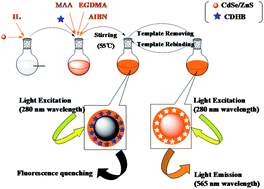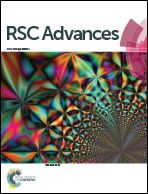A novel molecularly imprinted polymer on CdSe/ZnS quantum dots for highly selective optosensing of mycotoxin zearalenone in cereal samples†
Abstract
A novel molecularly imprinted optosensing material (MIOM) based on ionic liquid (IL)-stabilized CdSe/ZnS quantum dots (QDs) was prepared, for highly selective and sensitive recognition of the mycotoxin zearalenone (ZON). ZON is expensive and highly toxic, so the ZON analog cyclodo-decanyl-2,4-dihydroxybenzoate (CDHB) was instead used as the template. MIOM was characterized by scanning electron microscopy (SEM), Fourier transform infrared spectroscopy (FT-IR) and adsorption experiment. Under optimal conditions, the relative fluorescence intensity of MIOM decreased linearly with increasing ZON concentration, in the range of 0.003–3.12 μmol L−1. MIOM had a detection limit of 0.002 μmol L−1. MIOM was used to detect ZON in corn, rice and wheat flours, and at three concentration levels 50, 100 and 500 ng g−1, ZON recoveries for these three cereals were 94.2–98.7%, 93.1–107.6% and 84.4–106.0%, respectively.


 Please wait while we load your content...
Please wait while we load your content...